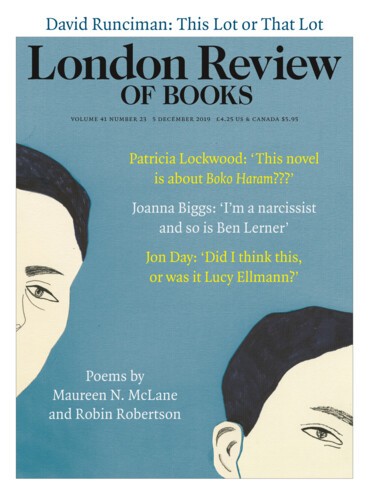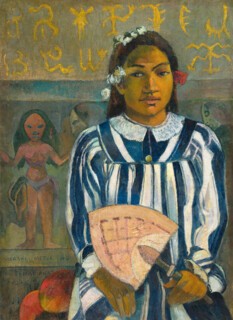Gauguin’s 1893 painting of Tehamana, the teenager with whom he cohabited during his first visit to Tahiti, shows her seated facing forward, yet her eyebrows no more match than the share and handle of a plough: one is a stout black wedge, the other a long curving arc. The eyes beneath them slip sideways, evading attention, and if you look closely you’ll notice that their sockets are tilted on subtly differing planes. For all this distortion, Tehamana’s head is a compactly moulded object, one you might clasp in your hands. Little clusters of serried brushstrokes have knocked it into shape, finished with crisp outlines where the lips and nose and chin curl away.
Gauguin greatly admired Cézanne, the proponent of pushed-about contours and interpenetrating hatchings. But where Cézanne worried about edges – about how objects coexisting in three dimensions could coexist in two – Gauguin sought essences. His paintwork grapples with Tehamana’s head in search of some inward principle that, as those averted eyes make clear, remains just out of reach. At various points in Gauguin Portraits (at the National Gallery until 26 January) it’s clear that this sort of curiosity could make his brush-drawing supple and lithe – in the little study, for instance, of a woman in a Breton coif, done from life in 1888, or the larger canvas of Madame Roulin, painted during his stay in Arles later that year. The paint-modelling is still more forceful in an 1893 portrait of the artist Louis Roy – his head a bulbous object that seems almost to detach from the canvas. There is a ready continuity from this to a vase modelled on the head and shoulders of Madame Schuffenecker, the wife of a friend. Roman soldiers joked that a head, a caput, was no more than a hollow pot, a testa, hence tête: Gauguin’s ceramics reanimate that etymology.
Heads fascinated Gauguin. The show includes a fantasia centred on a decapitated Tahitian king, and Gauguin Heads might have provided a more coherent title and remit than Gauguin Portraits. A portrait is, after all, attached to a definite identity. It’s true that you come across odd items at the National Gallery that fit this description: a respectful drawing-room piece of Mette, Gauguin’s Danish wife, from 1884, and an 1891 commission from Suzanne Bambridge, a grande dame of Tahitian colonial society, the result of which she apparently detested. But for the most part, identities dissatisfied Gauguin. He aimed for an art that proclaimed something beyond the fixed and knowable. Whether self-possessed Tehamana was also the model for the submissive and carnal ‘Tehura’, whose features Gauguin carved at a similar date, is impossible to tell: turn the block round, anyhow, and a figurine carved on the back morphs Tehura into Eve in paradise. Personality fades away in an indefinite trail of connotations. A bigger block, this time of rough-hewn oak rather than fine-grained local wood, depicts the artist Meijer de Haan as an august spirit of the woods; but in the canvas Barbarian Tales (1902) de Haan’s physiognomy is given to a pink-skinned, demonic intruder ogling two beauties in a tropical glade.
Gauguin liked to keep the essence of the person or the ‘tale’ elusive: shiftiness was his speciality. Of the many self-portraits on view at the National Gallery, none is more affecting than the earliest, which shows Gauguin aged 36, a business failure in a chill Copenhagen attic. His eyes veer away from ours just as Tehamana’s do, but here out of desperation to flee bourgeois life – a flight that would take him to Brittany, Martinique, Arles and Tahiti, ending, almost twenty years later, on the remote Marquesas Islands. Gauguin’s deflections went beyond heads, no matter how meaning-packed they might appear. He latched onto Degas’s Woman Seated beside a Vase of Flowers (1865): again and again, he revisited its teasing proposal that a still life could take centre stage and marginalise a portrait study (as in his studies of his artist friends Charles Laval and Władysław Ślewiński). Perhaps he hoped the displacement would open up some poetic ellipsis. But no such imaginative impact arrives.
What does arrive at various points in the National Gallery show is colour. Yellows, above all, are the consummation of this art – from the lemons of a Breton smock to the golden browns of Tahitian skin. Gauguin’s achievement was to set off those hues among others that allow them to sing, in fervent, heart-heavy arrangements. This is where the trail that leads away from identity ends. Gauguin himself loved to invoke the idea of ‘abstraction’, and the old genealogy that runs from him to Morris Louis still, on this evidence, holds good. There is also a less deliberate, more instinctual modernist on view: one whose brush thrusts on blindly, having lost sight of its drawing, into a deepening thicket of paint. You catch him in the act, for instance, in the right half of the melodramatic self-portrait Christ in the Garden of Olives (1889).
But there is another instinct on display in this show that drags on me, and it isn’t only the fault of the curators, though their exhibition, I’m forced to say, doesn’t look that good. Seemingly strapped for major loans, they’ve filled the galleries with too many off-pieces, and their catalogue arguments – which claim that flowerpieces and totemic doorposts can be designated ‘portraits’ – carry no visual conviction. Nor, since we are so often brought face to face with him, is it entirely a matter of Gauguin’s provoking ‘Why shouldn’t I?’s, though these feed my grouch. (Why shouldn’t he accept a government assignment to study Tahitian culture? Why shouldn’t he then declare himself a ‘true savage’? Why shouldn’t he then sleep with a 13-year-old?)
The painting of Tehamana is firmly and inventively put together; the women in Barbarian Tales likewise. When he had self-enclosed bodies to attend to, Gauguin could be a powerful moulder. But at the object edge his thought process cuts off. Tehamana has her missionary frock, her hands, her plaited fan, her mangoes on the bench: but each of these is a discrete task of rendering, applied to a rigid groundplan. Degas may have reciprocated the admiration of Gauguin, who in turn inspired Picasso, but in this regard those other artists (not to mention Cézanne) show greater mental energy. Every mark they make speaks to every other mark. Gauguin tends to pile up objects. He wants to salute the cultural richness of so-called ‘savagery’ – the painting’s inscription reads, ‘Merahi metuano no Tehamana’ (‘Tehamana has many ancestors’) – but he still thinks like a government positivist. More components equal more meaning. Borrow from Hindu figurines for a Tahitian mother goddess. Borrow a sample of the sole indigenous Polynesian script – all the more irresistible for being indecipherable – from someone who’s been to Easter Island. And so on.
The bits accumulate rather than integrate: it’s low-level thinking. And Gauguin’s reach is so capricious – he lifts not only from India and Polynesia, but from Borobudur, Persia, Raphael and, of course, from photography, especially in those blustering self-portraits. ‘If you reproduce what another has done, you are nothing but a maker of patchwork’: how did he have the nerve to write that in his journal? One would need another show to know how to look him square in the eye, how to reconcile this grappler with form, this visionary of colour, with the man playing with bric-à-brac.
Send Letters To:
The Editor
London Review of Books,
28 Little Russell Street
London, WC1A 2HN
letters@lrb.co.uk
Please include name, address, and a telephone number.


